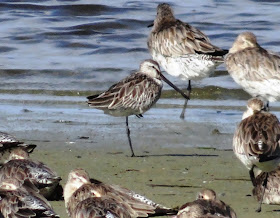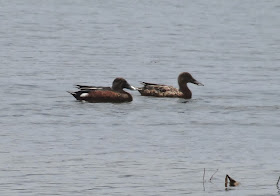 |
| Southern Gastric-brooding Frog |
Every now and then, I can't resist. I did it again this week. I searched rainforest streams in the Conondale Range, in the Sunshine Coast hinterland, for one of Australia's truly extraordinary critters - the Southern Gastric-brooding Frog,
Rheobatrachus silus. I failed to find any. However, a nagging question lingers in the minds of many. While the frog is generally believed to be extinct, may it still be out there somewhere? A succession of wet summers in recent years - following a prolonged dry period since the disappearance of
Rheobatrachus in the late-1970s - fuels hopes that the Tasmanian Tiger of the herpetological world may yet live.
After all, what are the odds of this frog, with its unique breeding biology - the female raises its young within the stomach - being known to humankind in the wild for a miserly seven years?
 |
| Southern Gastric-brooding Frog |
The frog was discovered by David Liem in Kondalilla National Park in the Blackall Range in 1972. Its breeding behaviour was first recorded in 1974, not by Adelaide herpetologist Michael Tyler, as is widely reported, but by a group of young people - Chris Corben, Debbie Raven, Anita Smyth and myself - who shared a house in the Brisbane suburb of Red Hill. Chris first spotted a strange bulging in the stomach wall of a female we had captive in an aquarium. I recall the moment vividly when Debbie shouted that the frog was spewing baby frogs from its mouth. Chris Corben and Glen Ingram quickly sorted out what was going on; Tyler was invited to join the party later. This breeding behaviour was so bizarre - normally gastric stomach juices would destroy eggs, tadpoles or baby frogs - that the journal
Nature thought the finding was a hoax.
See here for a more detailed account.
The frog was last seen in the wild in Booloumba Creek in the Conondale Range in 1979 (captive animals survived a few more years). The Southern Gastric-brooding Frog was known only from the adjoining Blackall and Conondale ranges. A close relative, the Northern Gastric-brooding Frog, was found at Eungella, in the Mackay hinterland, in the early-1980s but it has similarly disappeared. These frogs vanished along with other amphibian species in Australia and elsewhere, presumably due to atmospheric or environmental changes of some kind facilitating the spread of the deadly chytrid fungal disease.

The Southern Gastric-brooding Frog lived in higher altitude (around 450 metres) rainforest streams, but I found one in 1976 in a tributary of Booloumba Creek near the present day camping grounds at an elevation much lower than normal. The site is pictured above, and I returned there this week. The frog extinctions occurred essentially at high altitudes so I harbour hopes that lower altitude sites such as this were spared the worst of the chytrid plague. I donned reef shoes and plastic pants for my three-hour search, upturning numerous rocks in suitable-looking pools. There were plenty of aquatic spiders, crayfish and other critters, but no frogs.
Undeterred, I moved on to one of the frog's best-known high altitude sites - a sector of Booloumba Creek in Conondale National Park formerly known as Beauty Spot 100. This is the place (photographed yesterday in the image above) where Glen Ingram undertook a scientific study of
Rheobatrachus before it disappeared. It is one of several sites where a certain Queensland Government scientist (he knows who he is) collected a large number of specimens - far more than was justified. This is also the spot, by the way, where I rediscovered the
plumiferus race of the Marbled Frogmouth (
see here). It almost beggars belief that notwithstanding the obvious environmental significance of this site, it was logged intensively by the Bjelke-Petersen Government in the early-1980s.
The frogs had been quite numerous here and could be readily found under rocks. I searched many of the pools where they occurred this week but again there was no sign of frogs. This remains a hauntingly beautiful spot, however: I never fail to be in awe of it.
The likely loss of
Rheobatrachus was hopefully not totally in vain. The frog became the powerful figurehead for a vigorous campaign to save the Conondale Range from logging, mining and clear-felling for hoop pine plantations. In the image above, I was giving a media conference in 1977 about the frog and the need to save the Conondales; a Southern Gastric-brooding Frog is in the aquarium on the desk. The campaign to save the area was boosted significantly by the frog's disappearance amid concerns that it may have been related to development pressures.
Ultimately, the efforts of many dedicated people over a couple of decades prevailed. The core forest areas of the Conondale Range are now protected in the 35,500-hectare Conondale National Park. Mining, logging and clear-felling native forest was stopped. Yet a new threat has emerged with the pending review by the Campbell Newman-led Liberal National Party Government of national park declarations by former Labor governments (
see here). Most of the Conondale National Park (the sign in the image above, near Charlie Moreland Park, is quite new) was added by the Labor administrations of Wayne Goss and Peter Beattie.
Meanwhile, I continue to quietly wonder. Are they still out there?






















































